 zachary harden
zachary harden
Keywords: ufe | unidentified flags | 2021 |
Links: FOTW homepage | search | disclaimer and copyright | write us | mirrors

Last modified: 2025-02-07 by  zachary harden
zachary harden
Keywords: ufe | unidentified flags | 2021 |
Links: FOTW homepage |
search |
disclaimer and copyright |
write us |
mirrors
Please note our Policy for Submissions and Enquiries.
Below is a series of images of flags that have been provided to FOTW; some we have recognized, and some we have been unable to recognize. If you can help us identify any of these flags, please let us know! Contact the: UFE Editor.
Identification Key:
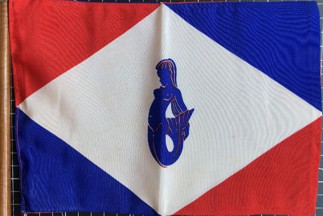 Image from Nigel Owen, 21 April 2021
Image from Nigel Owen, 21 April 2021
I have a flag I can't identify and was wondering if you could help please. The flag is red and blue over blue and red horizontal bicolour, superimposed by a white lozenge touching the edges and containing a blue mermaid.
Nigel Owen, 21 April 2021
This flag does look familiar, but I cannot place it myself. The quartered design, the white lozenge and the mermaid all suggest a marine connection, likely a shipping line.
Rob Raeside, 21 April 2021
I believe, this flag is already in our UFE collection and unfortunately not identified. It was part of a bunch of three or four images. I think, Pete will know best.
Klaus-Michael Schneider, 21 April 2021
Unlikely, but a better picture this time, it is the center flag at UFE20-6 that Nigel submitted last year. Not much happening there, but perhaps Nigel discovered the identities of the other two since last year?
Pete Loeser, 21 April 2021
When I look at this flag I have strong suspicions about it being a unit pennant of the French navy. Compare its design to the honour jacks of WW2.
The mermaid itself is an indication. The French word for mermaid is "sirène." And, without much surprise, there have been ships named Sirène in the French navy since at least the XVIIIth century. After being the name of a class of submarines in the 20s, it was born by two modern submarines from 1952 to 1996. (source)
From this I guess this flag is either a unit pennant (official flag) or a tradition pennant (unofficial) which belonged to the last submarine which was called Sirène. Unit pennants are regulated and are either 40-50 cm or 30-40 cm so if its size does not match it could be a tradition pennant, not regulated as far as I know.(source)
Corentin Chamboredon, 21 April 2021
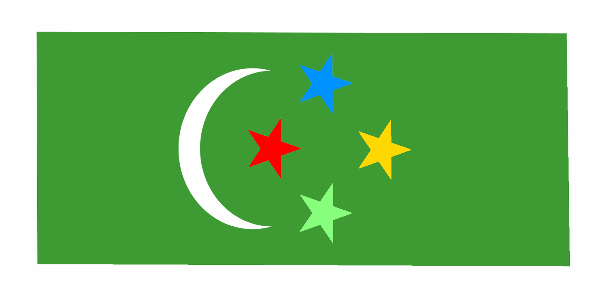 Image from Graham Baxter, 21 April 2021
Image from Graham Baxter, 21 April 2021
I was driving through rural Kenya (Turkana County, to be exact) in 2018, and I saw this on a flagpole near a rest stop. Any idea what it might be?
Graham Baxter, 21 April 2021
 Image from Rainer Gelke, 8 April 2021
Image from Rainer Gelke, 8 April 2021
This question is based on a post card, probably from 1905. Rainer Gelke asked, what the flag on the right side of the card might be. I had to offer only an educated guess. I presume the inscriptions Flanders and Wallonia belong to the two lions. And the flag on the left isn't the flag of Flanders, but that one of the Kingdom of Belgia itself. The right flag in question has similarities to that one of the Congo Free State (1885-1905). The upper half displays a yellow star in a blue field (like the flag of the Congo Free State) with an additional green stripe below. Can anybody assist?
Klaus-Michael Schneider, 8 April 2021
Based on the text in the medallion bearing the name of Leopold II, the flag is clearly an erroneous depiction of the flag of Congo Free State.
Tomislav Todorovic, 8 April 2021
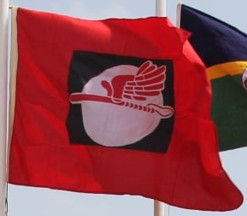 Image from Paul Bassinson, 8 April 2021
Image from Paul Bassinson, 8 April 2021
This unknown flag was shown flying beside that of the Nigerian Police Force.
Source: This Facebook picture.
Paul Bassinson, 8 April 2021
This is a Nigerian Mobile Police flag as you can see, by these articles:
 Image from Paul Bassinson, 2 May 2021
Image from Paul Bassinson, 2 May 2021
Attached is an image of three unidentified Guatemalan sporting flags (besides the Guatemalan Olympic Committee and the Guatemalan national flag, obviously). (source).
Paul Bassinson, 2 May 2021
Identification is as follows:
CONADER (Consejo Nacional del Deporte, la Educación Física y la Recreación - National Council of Sport, Physical Education and Recreation) is the inter-institutional coordinating body of the Ministry of Culture and Sports, through the Directorate General of Physical Education, the Autonomous Sport Confederation of Guatemala and the Guatemalan Olympic Committee.
Source: Official website
Photos:
- source #1.
- source #2.
- source #3.
 Image by Ivan Sache, 3 May 2021
Image by Ivan Sache, 3 May 2021
CDAG (Confederación Deportiva Autónoma de Guatemala - Autonomous Sport Confederation of Guatemala) was established by Agreement No. 2&& issued on 7 December 1945 by the Ministry of Public Education and had its Statutes promulgated on 28 April 1946. CDAG groups 29 sport federations.
Source: Official website
Photos:
- source #1.
- source #2.
- source #3.
- source #4.
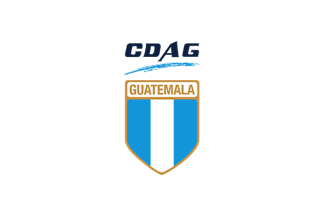 Image by Ivan Sache, 3 May 2021
Image by Ivan Sache, 3 May 2021
DIGEF (Dirección General de Educación Física - Directorate General of Physical Education) was established on 26 November 1947I It was incorporated on 8 October 1986 to the newly created Dirección de Educación Física, Recreación y Deportes Escolares (DEFREDE - Directorate of Physical Education, Recreation and School Sport), placed under the tutorship of the Ministry of Education. The DIGEF was re-established by National Law of Physical Education and Sport, promulgated by Decree No. 76 in 1997.
Source: Official website
Photos:
- source #1.
- source #2.
 Image by Ivan Sache, 3 May 2021
Image by Ivan Sache, 3 May 2021
I visited the Confederate cemetery in Helena Arkansas today. Flying at the top of the monument is the navy blue flag with a white disc in the center. It looks like the one pictured on your site. You say it is also in a Roy Cross painting. I'm curious about the connection to the Confederacy.
Roby Neomara, 6 May 2021
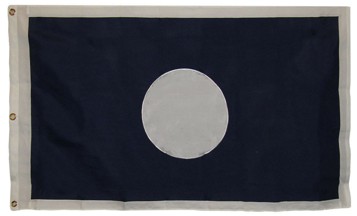
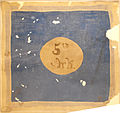 Images from Pete Loeser, 7 May 2021
Images from Pete Loeser, 7 May 2021
If you are referring to UFE04-18, that was an enquiry about a flag shown in a painting by Roy Cross of a Clipper ship in the Arctic. The only connection to the Confederacy in the rather inclusive discussion was that one participant mentioned the blue flag was similar to the Hardee Flag design his family uses.
That said, the flag you saw flying over the cemetery is most likely a generic white on blue version of the CSA Hardee Battle Flag. It was very popular with the western Confederate troops and has not become the political football that the Battle Flag of the Army of Northern Virginia is today. Arkansas Major General Patrick Cleburne introduced the Hardee pattern for his regimental flags. It was first flown in battle by Hardee's Corps of the Army of Tennessee (Third Tennessee). It had originally been designed by General Simon Buckner and used by his troops in January of 1862, but not yet in battle. Among the Arkansas units that later carried variants of this flag were the 5th, 6th, 7th and 8th Arkansas Infantry Regiments and Key's Artillery Battery, to name a few. Later versions had borders around them as shown in the two attached examples from Arkansas. It should also be pointed out that a large number of Tennessee regiments also used this style of battle flag, in fact, it is also called the "Tennessee Moon" pattern.
Notice how the 5th Arkansas version (attached) has the text "5th Ark." written in the white circle. It was common for the units using these flags to add their identity in the white circle. They also added battle honors as the war progressed. Some variants replaced the blue backgrounds with other colors as shown on the white on black example.
Pete Loeser, 7 May 2021
This flag has been Positively identified and can be seen on this page
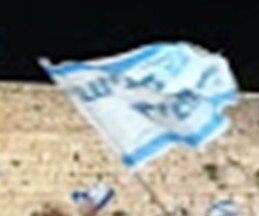 Image from William Garrison, 11 May 2021
Image from William Garrison, 11 May 2021
I found this flag's image at the above source. But it was obscured in part by a "motion arrow" in a film clip. By clicking onto the image and then clicking on "search Google for image" I found a clearer photo.
The caption read: May 10, 2021, marked Israel's annual "Jerusalem Day" observance alongside the "Wailing Wall" at the "Temple Mount" in Jerusalem. An unidentified flag resembling the national Israeli flag, but with slogans in Hebrew. I do not know whether or not this flag is one made specially for the "Jerusalem Day" rally, or is some Israeli political party flag. Perhaps an FOTW associate in Israel can provide a translation and clarification.
Source: Jerusalem Post Article.
William Garrison
 Image from Jason Saber, 12 May 2021
Image from Jason Saber, 12 May 2021
This was posted as a "Possible maritime flag of the Vietnam People's Army Border
Defense Force" on the FOTW FaceBook page. I have no further information or confirmation about this but thought one of you might recognize it.
Jason Saber, 12 May 2021
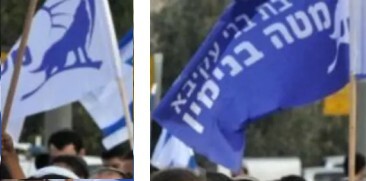 Image from William Garrison, 11 May 2021
Image from William Garrison, 11 May 2021
Right-wing Israelis in Jerusalem have had much to celebrate this week, but their happiness serves to highlight the disenfranchisement felt by Palestinians across the social spectrum.
The caption reads: "Israelis celebrating 'Jerusalem Day', May 13, 2018." Two unidentified flags: far-right is a blue flag with white lettering in Hebrew, and at far-left is a white flag with what appears to be images of a howling wolf and sun rays.
Source: France 24.
William Garrison, 11 May 2021
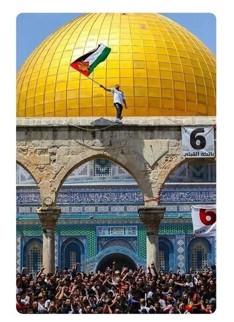 Image from Marc Pasquin, 10 May 2021
Image from Marc Pasquin, 10 May 2021
This picture sent by Azz Ahmed on the FOTW facebook page asking if the defaced Palestinian flag seen at the top of the picture is the palestinian presidential flag. The picture is taken in front of the Al-Aqsa Mosque in Jerusalem, but there are otherwise no other details given.
Marc Pasquin, 10 May 2021
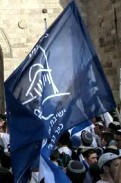 Image from William Garrison, 7 May 2021
Image from William Garrison, 7 May 2021
image trimmed from original photo.
The caption on this flag reads: "On the annual 'Jerusalem Day' national holiday, Israeli flags are marched through the Old City's Damascus Gate (here in May 2016). [photo credit: Oliver Fitoussi]." This parade celebrates the re-unification of Israeli-held West Jerusalem with Jordanian-held East Jerusalem, when Israeli troops seized the eastern quarter of the city during the June 1967 'Six Day War'. (In opposition, many Muslims celebrate with their annual "Quds Day" that is held on the last Friday of Ramadan.) In the original photo there were the obvious Israel national flags, but the flag of interest is this blue flag with imagery of a white mosque and slogans in Hebrew. Perhaps one of your Israeli contacts can provide a translation of the Hebrew on the blue flag?
Source: Haaretz News.
William Garrison, 7 May 2021
 Image from William Garrison, 9 May 2021
Image from William Garrison, 9 May 2021
I emailed you a similar email regarding "Jerusalem Day", but that revealed a "Jerusalem Day" flag that appeared in 2016. The below photo shows a different "Jerusalem Day" flag in 2019. Apparently, two different flags.
The caption this June 2019 flag reads: "On the annual 'Jerusalem Day' national holiday, Israeli flags are marched through the Old City's Damascus Gate" (here on June 1, 2019 - because the Hebrew calendar differs from the Western Gregorian calendar, the date of this holiday varies yearly). This parade celebrates the re-unification of Israeli-held West Jerusalem with Jordanian-held East Jerusalem, when Israeli troops seized the eastern Muslim quarter of the city during the June 1967 "Six Day War". (In opposition, many Muslims celebrate with their annual "Quds Day" that is held on the last Friday of Ramadan.)
In this photo there are the obvious Israel national flags, but the flag of interest is the flag at far right that appears to have slogans in Hebrew. (To my eyesight, there also appears to be a different flag on the left side. Both of these unknown flags have a broad blue stripe at the top and bottom, whereas the Israeli national flag has a white-stripe above and below their blue stripes.) Perhaps one of your Israeli contacts can provide a translation of the Hebrew on the blue flag, or offer a better image/information.
Source: Haaretz News.
William Garrison, 9 May 2021
 Image located by William Garrison, 18 May 2021
Image located by William Garrison, 18 May 2021
I tried research on FOTW for this flag, but, as I do not read French well, I could not locate it.
The text on flag translates as "Association of former residents and families of the Drancy camp" It's caption says "unidentified French flag, c.July 2017. (Benyamin Netanyahu at the commemoration of the 'Vel d'hiv' roundup, July 16, 2017). Erez Lichefeld/YadVache"
William Garrison, 18 May 2021
From a pure vexillological point of view, interest is limited. The flag is of the pattern used by French associations of war veterans, prisoners etc.: French national flag with an emblem in the center and the association's name in gilded letters. (French Ceremonial Flags of Veterans' Associations)
For this particular case, the writing says it all, referring to the camp of Drancy, used from March 1941 to August 1944 to "group" Jews in order to organize their transfer to the death camps. About 63,000 out of the 76,000 Jews deported from France transited in Drancy.
See a detailed presentation of the Drancy Shoah Memorial, which was inaugurated on 23 September 2012 close to the former camp.
Ivan Sache, 22 May 2021
 Image from Jaune Arc, 12 May 2021
Image from Jaune Arc, 12 May 2021
I found this weird yellow, orange, and green striped flag on a jacket I got in a rummage sale. I searched and found a picture the jacket that was described as a "Rocawear Men's Nature Pattern Zip-Up Jacket.". The label on sweater said R.O.C R534. I can't identify the flag below the patch.
Jaune Arc, 12 May 2021
This specimen referred to as a "flag" is simply a patch on a garment. (source). The patch clearly reads "ROCAWEAR" on top in black capitals and below "DENIM COMPANY" in white capitals, Rocawear being a U.S. clothing retailer based in New York (source #1) and (source #2). Also below there's an image resembling a pilot's wings (very similar to that of the VVS). It is indeed an outdoor jacket that according to its cammo pattern could be perfectly fit to use during hunting season.
This is a trend that has been around for quite some time (c1980's with the demise of the "Cold War") in which military surplus gear hasvbeen made available for civilians to wear, and also a tendency to havevvintage-style designed clothes (reproductions) displaying militaryvpatches (in this case, below the company's name one can see a German flag as a patch on the right hand side sleeve).
Esteban Rivera, 19 June 2021
 Image from William Garrison, 9 June 2021
Image from William Garrison, 9 June 2021
This flag was identified as Ministry of Defence (Israel)
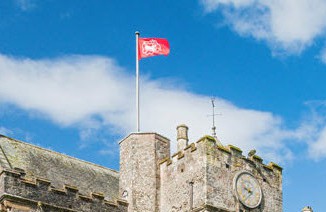 Image from Pete Loeser, 24 June 2021
Image from Pete Loeser, 24 June 2021
Can anybody identify the flag being flown above Dartington Hall in this picture. It is in located in Totnes in Devon County in England. The picture is located here on the Britian magazine website.
Pete Loeser, 24 June 2021
I found a better picture - it looks like a Paschal lamb, often associated with Saint John the
Baptist. Maybe a connection with the church?
Rob Raeside, 24 June 2021
Looks like a variant of the flag of the National Trust, a charity for heritage conservation in England, Wales and Northern Island. The logo shows an oak twig with or without the letters "National Trust", and is shown in many different color combinations.
Dirk Schönberger, 24 June 2021
The logo seems to be a abstract representation of the hart and rose badge which is connected to Dartington and which is used in several ways for things related to Darlington (like the school, some tweed clothes, a sports club, a British navy minesweeper). I have not seen any logo by the Darlington Trust itself yet on the Internet.
Examples:
- Dartington Hall School.
- Worth Point Plaids.
- Totnes and Darlington Football Club.
- Ton Class Association.
- The badge is shown as a roof boss at the manor house.
Dirk Schönberger, 24 June 2021
It seems it is Dartington Trust flag as shown here. There is also a flag of a similar trust organization used in Totnes at the Totnes Castle.
Valentin Poposki, 24 June 2021
This second flag is the logo of the English Heritage Trust, another charity which preserves historical buildings.
Dirk Schönberger, 24 June 2021
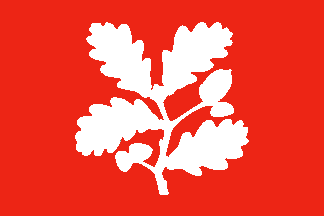 image by Pete Loeser, 24 June 2021
image by Pete Loeser, 24 June 2021
Speculative image of National Trust Flag.
The English Heritage has already been reported on FOTW on this page here. We also show the flag of the National Trust on this page here.
This said, I think we may be incorrect about the flag being that of the "National Trust." The shape of the emblem doesn't look quite right to be the National Trust logo as shown on my speculative image. I took the green on white image provided by André Coutanche and recolored it to match the flag on Dartington Hall. Also this list of National Trust properties does not include Dartington Hall. Admittedly the list may not be correct, but it is also unlisted on the National Trust website. Hopefully we can do some more research and verify exactly what the flag is on the hall. Can anybody in the area give Dartington Hall a ring and see if they can identify the flag?
Pete Loeser, 25 June 2021
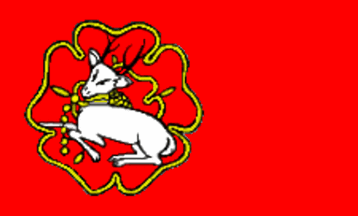 image by Pete Loeser, 26 June 2021
image by Pete Loeser, 26 June 2021
Speculative image of reversed Dartington Hall School Flag.
Dartington Hall sits on a historic 1,200 acres estate near Dartington, also near Totnes in south Devon. It is easy to confuse Dartington with Darlington in County Durham, but these places are at opposite ends of the England. The Dartington estate with its manor house dates back to Richard II's time, and earlier.
The import thing about this is that between 1926 and 1987 there was a school at the estate called the Dartington Hall School. It offered a really progressive and coeducational experience. At its largest size the school only had about 300 pupils. However in the 1980s, after the death of its original founders, the enrollment dropped and the school was forced to close in 1987.
After that, it became the headquarters of the Dartington Hall Trust, a charity whose mission is " to be a creative catalyst for more just and sustainable ways of living, as a centre for learning in ecology, the arts and social justice." It has sponsored seminars, summer sessions, and a host of activities, and just opened the Dartington Arts School at the hall with five new Masters programs, with names such as "Arts and Place" and "The Poetics of Imagination," whatever they might be.
The point is that the Dartington Hall School logo was a deer on a red background as I show in my speculative drawing. I now think the mysterious red flag might be the reverse side of either the old Dartington Hall School flag, or possibly one now being used by the Dartington Hall Trust.
I've placed the known logo on the speculative flag, but the images we have suggest it was done just using a plain white outline. Again, this is just speculation at this point, and hopefully we will learn more. I have inquired for more information.
Pete Loeser, 26 June 2021
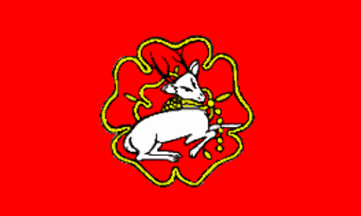 image by Pete Loeser, 26 June 2021
image by Pete Loeser, 26 June 2021
Speculative image of Dartington Hall School Flag as suggested by Esteban Rivera.
Here's my take on the issue: I'm more enticed to believe that the rendering of the flag submitted by Pete is actually correct, in the sense that the deer logo is the actual figure displayed on the flag. Also, there's a video, by the Dartington Trust, which shows the waving flag and it displays the deer logo in what appears to be a white outline (encirclement).
The image sent by Pete should then feature the logo towards the middle, instead of the hoist as it currently is, to match the flag seen on the video.
"Dartington Hall is built around 1388-1400 by John Holland, half-brother of Richard II, which is then held by the Champernowne family (1599-1925) (CoA seen here). Then Dorothy and Leonard Elmhirst, two American millionaires,
purchased the neglected 14th century Dartington estate. There was a company set up in the grounds of the Estate, Dartington Hall Limited (July 1,1929-February 28, 2017) which ran all economic activities (farming, forestry and educational projects). Then in 1932 "The Dartington Hall Trust" was established which oversaw Dorothy and Leonard's charitable work. Then the Estate, along with all its activities was transferred to this Trust in 1935."
Sources: Dartington Organization: Our History, Dartington Organization: Timeline, Wikipedia: Dartington Hall, and the Find and Update Company Information Service.
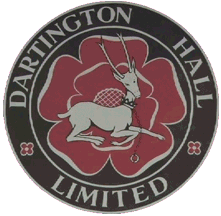 #31d
#31d
 #31e
#31e
 #31f
#31f
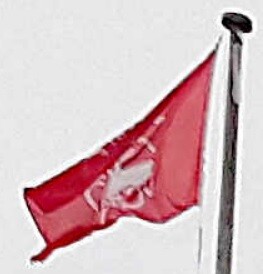 #31g
#31g
Images located Esteban Rivera, 29 June 2021.
Images attached are:
- #31d: (logo) (Dartington Hall Limited logo). This is the logo featured on the flag in honor of the family and its charitable work.
- #31e: (flag, obverse) (screenshot from this video at 1:31 ).
- #31f: (rev).jpg (flag, reverse) (screenshot from this video at 2:49 ).
- #31g: (rev1).jpg (flag, reverse, closeup) (cropped image copied from the original located here. (source)
Here's an additional video, again from the Dartington Trust, with the history of the estate.
One more thing I forgot to mention: in the message sent by Dirk Schönberger on June 24, he mentions a very important source. In this source, "Ross Badge", and this sub-article titled "Tales of a Ricardian Traveler _ Debunking a Myth at Dartington Hall" allows us to have a more thorough look into the history of the Estate and its symbol.
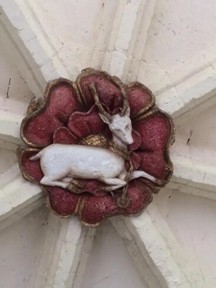 #31h -
image located by Esteban Rivera, 29 June 2021.
#31h -
image located by Esteban Rivera, 29 June 2021.
It mentions that "John Holland, (was the) first earl of Huntingdon and duke of Exeter." Also, the article mentions the conflict between the House of Lancaster and the House of York, which became known as the "Wars of the Roses."
This image's (#31h) caption read: "Late 14th c. Roof Boss showing Richard II's Badge on Cinquefoil Rose." (source)
For additional information please refer to Dartington Trust. (official website)
Esteban Rivera, 29 June 2021
The Dartington Hall crest, represented on its flag, is the White Hart on a red background. The White Hart was the personal badge of King Richard II, who probably derived it from the arms of his mother, Joan "The Fair Maid of Kent", heiress of Edmund of Woodstock. It may also have been a pun on his name, as in "Rich-hart". Dartington Hall was built between 1388-1400 by John Holland, first earl of Huntingdon and duke of Exeter.
He was born in 1352, the son of Joan, Countess of Kent, who later married the Black Prince. Thus, he was an older, half-brother to Richard II and part of the extended royal family. His early fame came as a soldier and jouster, but he also had a temper that could get him into trouble. In fact, according to the Oxford Dictionary of National Biography, his first "political act" was to murder a friar who had accused John of Gaunt of conspiring to kill the 17-year old Richard II. As a young man, Holland was very much under the sway of John of Gaunt, the latter being the senior uncle to the king and probably the wealthiest magnate in England, if not its most influential. But his relationship with Gaunt cooled, and Richard II became his patron instead. The favour he received was so extravagant (and included an earldom and dukedom) that Holland memorialized it by having Richard II's white hart badge constructed as a roof boss in the entrance porch at the great manor house he was building at Dartington Hall. Its location meant that every visitor who was received into his great hall would see Holland's overt connection to the king.
The crest is today the emblem of the Dartington Hall Trust. I'm afraid we don't have an image of it, but if you contact the Hall directly they'll hopefully be able to help.
Scott Pettitt, Senior Archivist, Devon Archives and Local Studies Service, Devon Heritage Centre, 16 July 2021
I have reached out (via e-mail) to the Dartington Hall Trust and await their answer. Hopefully they can provide us with a illustration of their plain "white" White Hart logo on a red background as used on their flag, or a photo of their flag off the pole so we can see the details.
Pete Loeser, 16 July 2021